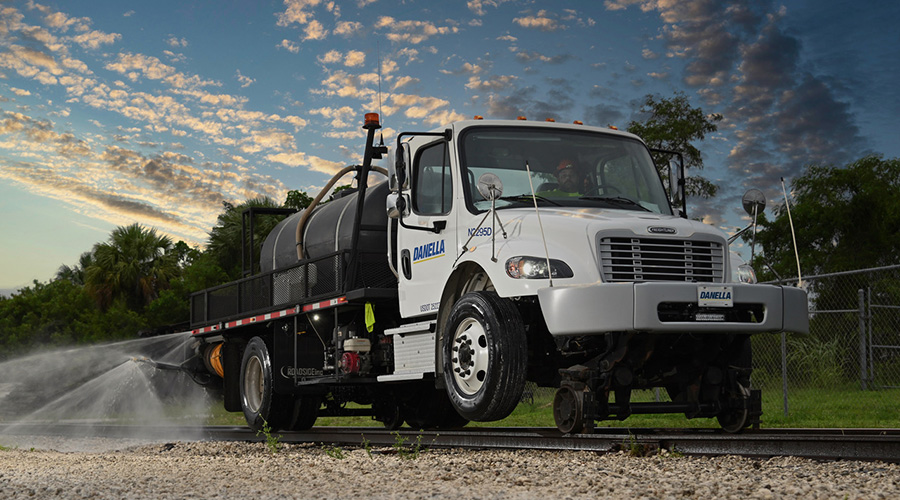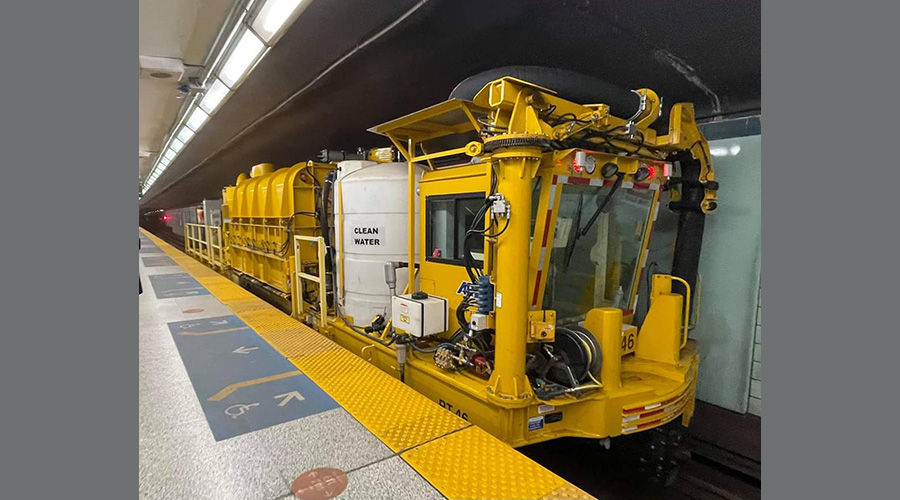Stay updated on news, articles and information for the rail industry
July 2008
Rail News: MOW
Suppliers continue to upgrade material distribution equipment
By Jeff Stagl, Managing Editor
Devastating floods that overwhelmed the nation’s midsection and submerged hundreds of miles of track last month underscored the nagging effects of network disruptions. Any loss of track time makes it difficult for railroads to deliver freight on time.
There’s no way to prevent train detours caused by natural events, but there are things railroads can do to avoid operational disruptions, especially in the maintenance-of-way (MOW) department. MOW managers long have sought to implement practices and acquire equipment that helps them minimize track time.
When it comes to handling and distributing MOW materials — be it rail, ties or ballast — managers are employing more equipment that can load and unload materials quickly and reach work locations without tying up track.
For example, CSX Transportation last year began using Brandt Road Rail Corp.’s OTM Tracker to load ties. A converted John Deere excavator featuring a boom and arm produced from high-tensile steel, the Tracker can quickly transfer from a truck transport deck to the top of maintenance rail cars and back, and handle ties, rail, plates and other materials.
“It can move via the highway,” says Ted Black, director of planning in CSXT’s MOW capital projects department. “If we didn’t use the Tracker, we would have to move other equipment on the railroad to get from point A to point B.”
Placing emphasis on ballast
Last year, CSXT also began using Georgetown Rail Equipment Co.’s (GREX) Gate Sync synchronized ballast gate unloading system with Solaris automated, remote unloading hardware to increase the accuracy and productivity of ballast placement.
Introduced in 2005, Gate Sync is designed to consistently deliver ballast precisely where needed. After a track survey is completed to identify target areas (including crossings, bridges and switches), data is downloaded into Gate Sync. The system then delivers ballast at speeds of up to 10 mph.
However, the system sometimes stops dumping ballast 500 feet short of grade crossings, requiring a manual train to fill in gaps, says Black. In addition, the system’s software has been set up for a depth of ballast delivered with six cars, and the railroad sometimes needs to use eight cars, says Steve Bell, manager-planning in CSXT’s MOW capital projects department.
Under constant adjustment
It’s been challenging to adjust Gate Sync to accommodate various car and gate sizes, and differing amounts of ballast loaded into each car at quarries, says GREX Vice President of Sales and Marketing Lynn Turner.
Ultimately, the goal is to achieve a no-dump zone of 20 feet before crossings and meet depth requirements regardless of the number of cars
involved and amount of ballast carried by each car, he says.
It continues to be an ongoing challenge for all material-handling equipment suppliers to meet railroads’ do-it-faster, do-it-accurately and move-it-off-track demands. To provide better options, suppliers are developing new machines or upgrading existing ones.
Soon, Brandt Road Rail expects to introduce the Brandt Rail Tool 120, a new model of the Brandt Rail Tool. The Brandt Rail Tool 120 will have the same capabilities as the larger 753 Brandt Rail Tool, but be more affordable, Brandt Road Rail officials said in an email.
Another tool of the trade
The Brandt Rail Tool 120 will feature two engines with a total of 289 horsepower and rubber tracks, and offer various attachments, including brush cutters, buckets, grapples, magnets, under-cutter bars, and a locomotive brake system and couplers to pull rail cars.
The machine is designed to travel on rail at speeds up to 30 mph and disengage from track in less than a minute so trains can pass by.
Modern Track Machinery Inc. (MTM) already has introduced a new material-handling option in the U.S. market. The PEM LEM panel and switch installation system features turnout-handling technology that’s been the standard in other markets for years, says General Sales Manager Alan Reynolds.
Using the system, railroad workers can pre-build turnouts at staging areas, move them to a new site — perhaps a mile or two away — and install them all with the same equipment, says Reynolds. A single operator controls switch handling and installation via radio control.
The PEM LEM panel and switch installation system maintains the integrity of the switch geometry, and excels in tight clearances with limited access as well as under catenary lines, says Reynolds.
MTM has explored other applications for the system, such as tunnels, ballast deck bridges and panel replacement, he says.
A rail pick-me-up
Sperling Railway Services Inc. also is marketing a new material-handling machine. Introduced early last year, the Rail Scrap Retriever is designed for rail replacement functions.
Currently used by CSXT, the retriever is equipped with crawlers for use with one piece of removed rail. The machine magnetically picks up spikes, anchors and tie plates, and conveys the material to a hopper, which can be dumped to either side.
The Rail Scrap Retriever reduces the number of machines and personnel previously required to pick up rail, Sperling Railway officials said in an email.
Herzog Contracting Corp. is offering a machine that’s relatively new to the market, as well. About two years ago, the company developed the Rail Unloading Machine (RUM), a special hi-rail truck equipped with adjustable computer-controlled, powered guide rollers.
The RUM is designed to provide a safe and productive method for unloading continuous-welded rails from a conventional rail train, Herzog officials said in an email.
Rails are pulled from the rail train with a telescoping crane operated by two Herzog employees and fed into a power box. Two adjustable guide rollers then steer the rail to the track shoulder. Two railroad employees are required to release the rails from the tie-down car.
The RUM eliminates the need for splice bars, cables, pusher cars and other material currently used in conventional rail unloading operations, Herzog officials said, adding that the machine also reduces the number of unloading cars required on a system and requires fewer railroad personnel for unloading.
Multi-faceted machine
Herzog also offers the Programmable Linear Unloading System (P.L.U.S.) Train for accurate ballast placement and Multi-Purpose Machine, or MPM, for ditching, OTM and tie distribution/pick-up functions, as well as magnet clean-up work behind steel gangs.
The MPM is a self-propelled unit operated by one Herzog employee. A specially designed crawler hoe moves on top of six well-type cars and is controlled by an operator, who indexes the movement of the consist as needed. For long moves, the MPM can be placed in end-of-train movement and be pulled at track speed, according to Herzog.
Slotting them in
Meanwhile, GREX offers several other pieces of material-handling equipment in addition to Gate Sync. The company markets the Slot Machine and Self Powered Slot (SPS), which are used by Class Is, short lines and commuter railroads.
The Slot Machine features articulated gondolas with all of the bulkheads removed except for the end pieces.
Cover plates bridge the transition between cars. The configuration supports the transport and utilization of a CAT 315 Track Loader, which can travel up and down the length of the consist without spending the typical transition time between cars — increasing production in shorter work windows, GREX’s Turner says.
Productivity push
The machine can be equipped to work with buckets, grapples or magnets, enabling the Slot Machine to handle ditching, tie set-out/pick-up and OTM pick-up functions.
The SPS functions similarly as the Slot Machine, but features a power unit in the consist. Controlled by a single operator, the SPS allows railroads to take advantage of the Slot Machine’s productivity without having to dedicate locomotives and train crews, Turner says.
Along with other railroads, CSXT is monitoring suppliers’ research and development efforts as part of its never-ending search for more productive material-handling equipment.
No. 1 on the R&D list is a recently developed prototype mobile unit designed to load or unload a rail train and travel quickly to the next rail train location.
“We have 30 rail trains and maybe 12 pieces of loading/unloading equipment,” says CSXT’s Black. “This mobile unit could get to rail train locations much faster.”
— Jeff Stagl


 2025 MOW Spending Report: Passenger-rail programs
2025 MOW Spending Report: Passenger-rail programs
 Gardner steps down as Amtrak CEO
Gardner steps down as Amtrak CEO
 Guest comment: Oliver Wyman’s David Hunt
Guest comment: Oliver Wyman’s David Hunt
 Women of Influence in Rail eBook
Women of Influence in Rail eBook
 railPrime
railPrime








